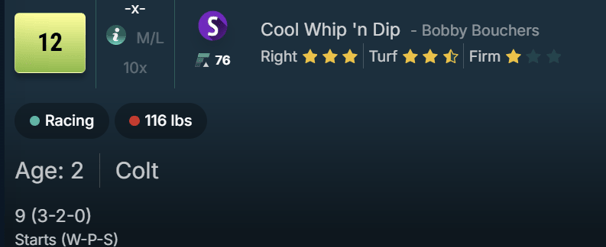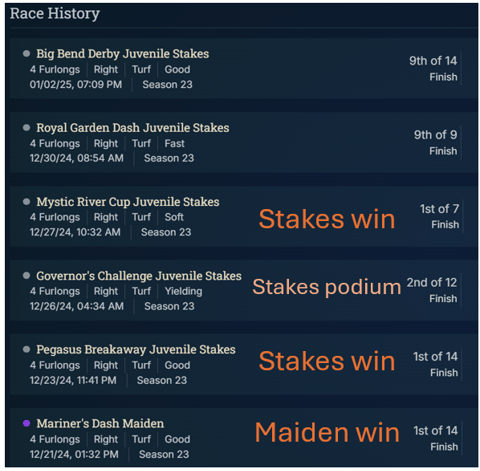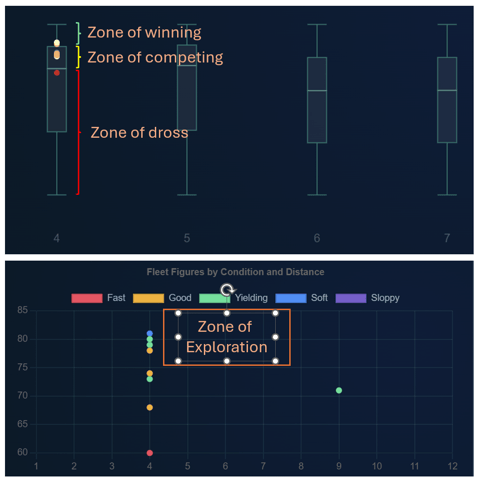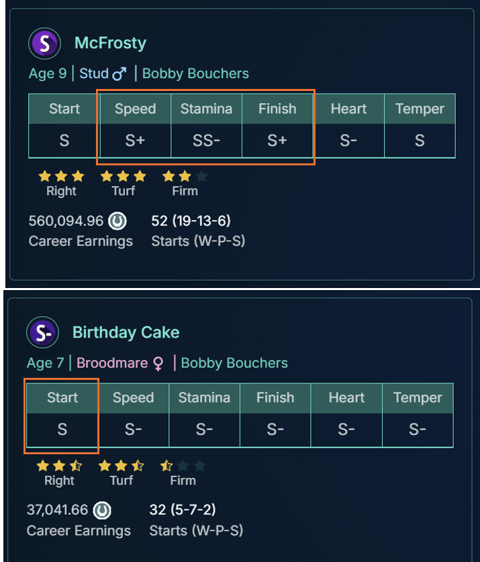How to find good claimers in PFL
Take advantage of what the game is telling you in PhotoFinish.Live (PFL) when it comes to claiming. Whilst 3rd party tools are extremely useful, you probably aren't using what is right in front of your eyes.
ai_paddock
1/3/20259 min read


Third party tools for PFL are great. They add tremendous value to the community. From Gap Data to MJ Informatics to PFE for in depth analysis. Getting form cards from https://pfldrf.com/. Or setting alerts with https://www.photofinishgiddyup.com/.
However, a smart player will take advantage of all the information the game freely provides. Hopefully you didn't click on the links in the last paragraph and are still here to read what follows... (bad UX 101 I know)
For once, this post is only going to leverage information contained within the UX of the game, no external data analysis or tools, APIs, scripts or data science shenanigans.
Assessing Claimers
If you want a quick method for evaluating claimers, here is what I do. Go to the Races page and type claim into the search bar to bring up imminent claiming races. Remember you need to make a claim more than 10 minutes before the off, so anything under 15 minutes doesn't give you enough time to do some research and talk yourself out of making a dumb mistake.
If you want to understand how to win the big seasonal claiming prizes follow and read Betelgeuse's thread on X. We are not concerned about such grand strategy here. Instead we are bargain hunting in the discount bins. It stands to reason that the less you spend on a claimer, the lower your risk, the less chance of sunk cost fallacy ruining your future decision making, and the less attached you might feel towards the horse. Spending 5k on a claimer, when few horses cost that much on the marketplace, means you know what you are looking for. We are going to focus on the 400, 800 and 1200 Derby races. You can breakeven on these horses with a single podium. My guess is most people are far more rational with their loyalty to, and race selection for horses picked up cheaply in the claimers than their own bred foals. That's good because we want to be cold in a decision making, not giving the horse 3 more chances to prove itself because the breed cost was so expensive. No sunk cost fallacy will set you free.
So let's take a look at a random claimer from today (3rd Jan 2025): https://photofinish.live/races/season0023-custom-4174e988-aa8f-4064-881b-f800933fd4f9. A 1200 Derby S grade, 4F fast claimer. We are going to start with broad heuristics (rules of thumb) - no need for models or complex filters here. If you want to play along, without worrying too much about the result (we are looking for untapped potential not claimer winners), pick a horse you think stands out from the pack. Got one? Okay you can now read on.
Step 1: Filtering
I like the look of #12 Cool Whip 'n Dip. It jumps off the page to me for a couple of reasons. First it has won 3/9 races. You can't usually find anyone selling a horse with that hit rate on the marketplace. Second it has the highest benchmark of 76. 76 is pretty high for a cheap claimer.


All we are doing at the moment is filtering. We can't jump to any conclusions until we have double-clicked into the details. What makes juvenile claimers more intriguing, is the owner's understanding of the potential of the horse is much less. This is most true early in the season, which is the best time to take a punt on a lightly raced horse entered into claimers.
How can you filter lightly raced juveniles? I would see if they showed potential in their first runs, check whether the owner and my interpretation of their likely optimal distance tallies up, check the bloodline - particularly looking for +subgrade downrolls (these are more likely to be +subgrade horses themselves). At 400 Derby per claim, you can play the odds of a lower strike rate on good horses. After all ten 400 derby claims are the same cost as one external breed, and you don't need to wait 3 months to race it.
We need to qualify these wins and the benchmark through recent race history. In the current meta, horses can have inflated win rates through winning multiple low level claimers, which also tend to inflate benchmarks too by awarding high FF ratings for those winners. So we need to check out win quality and recent FFs.
Step 2: Qualifying


Okay - so we may have struck gold here. The three wins were a maiden and two stakes races (qualifiers) plus an additional second place. What does that tell us? Well this young horse can probably win stakes races in the future. If it can win stakes it can win allowances too, and even if doesn't age well, it would still be profitable running Allowances (although S grade horses are in a bit of sticky spot with Allowances). Hell, it could even win 2.5k Claimers, which if nothing else, would double your money should it claimed. It is also vital here to check the horse is not just winning weak small field races through the skill of the owner padding the stats. One of the stakes wins was in a full 14 horse field and the 2nd place was in a 12 horse race. Again these are good signs.
This is a great outcome, and probably worth a claim. Not only did it win a stakes race, but it backed it up - so we can rule out extreme luck as the cause. The next stage is to understand any latent upsides or downsides of this horse.
Step 3: Latent Potential
I see a horse like a poker hand. How many outs does this hand have? What are my implied odds of winning a large hand? What are the upsides?


We already know it has won multiple stakes races, but there are some other elements we need to check. The first one is this horse is present in what I call the "Zone of winning" - which is just the area above the box on the boxplot chart. Good horses spend their time in the zone of winning. An absence from that zone may suggest limited upside (implied odds), and the races that were run were weak races (few participants or a weak field). The Zone of competing is where weaker races are won, and weak-ish races can be podiumed in. A horse that tops out in the Zone of competing (the 2nd quartile) is not a top 25% horse (be definition). Obviously horses cannot solely live in the Zone of winning but failure to register in the is a sign in itself of limited upside (unless the horse has hardly run). Residency in the Zone of dross is a bad sign, and means you need to try another distance or give up with this horse. That is not the case here at all.
The second chart from the game UX plots FF ratings by distance and going. Here we see the horse easily hitting 80+ but perhaps most interestingly has not been raced at 5-7F. It might be a 4F specialist - and if it is great - we know it can win stakes races at that distance. But maybe, its even better at 5 or 6 furlongs. The misleading part of the this FF chart is that it rebases the y-axis as performances change. At the moment it feels like 4F performance is great, but if it ran an 85F at 5F, all those points would move down the chart as the axis expanded. Be careful of these tricks of the UX. Let's check out the parents for a clue on optimal distance.
Step 4: Race Strategy


A quick check of the Bloodline tab and we can see that whilst the mare has its stronger attribute in Start, it was never run at 4-5F and was most successful at 7F. The stud was a monster 8-10F horse (500k+ earnings). So perhaps there is more to come from this horse in the 5-7F range? It's definitely worth a punt particularly given the class specific mini-majors distance is 6F for sprinters and this is where the real money is.
If I were to claim this horse, and given my stable is nowhere near the quality of Bobby Bouchers, an excellent stable owner with a great record, I would adapt the racing strategy slightly. I would continue trying to make money from 4F stakes races, and if the aging factor goes against me I would be hopeful of still profitably running Allowances, given this horse is already a proven stakes winner. I would also test running 5-6F to see if there is comparable or better performance there. 6F is where the finals are run that would open up more profitable spots to race.
Using the tools you are given
Hopefully this example shows how easy it is to use the tools you are given in game to find decent horses to claim. This horse was identified in less than a minute. Now, it might take 100 horses to come across one as potential solid as this one is, but the process of finding value in claimers is pretty simple:
Find low cost claimers, preferably 1200 or below and 2-3 year old horses
Eyeball a racecarrd and filter for horses with multiple wins and a high benchmark rating
Qualify those wins and FF ratings - has it won a stakes or allowance race - that is key
Check whether those wins were quality or weak wins (eg field size)
Does the horse inhabit the Zone of winning, or just the Zone of competing? Or is it dross?
What potential upsides does the horse have? Can it win at a higher level?
Would you race it differently? Is there evidence for a different distance strategy?
At the end of the day do you think it can win the next level up claimer and allow you to at least breakeven?
All this can be done in a minute with the UX of the website. As soon as you are not happy with the outcome of one of these steps move on. Over time you will get faster at evaluating an entire field in a few seconds. Due to the nature of when these races fill or hit their cut-off, new claimers appear all the time, often with a four hour window of opportunity. A good sign you are on the right path is if other owners are making the same claims that you do. If you don't want to risk your money upfront then make a note of the horses you predict are good claims and check their results a week later. If they won a non claimer, or podiumed in a full race, they would have probably paid for themselves already.
Claimers set floor prices for the marketplace. The market is where you can buy unraced foals, if you can see the potential. It's also full of overpriced horses that nobody wants. Good horses are snapped up immediately if the price is right and so a causal perusal of the marketplace is often void of good racing age bargains. That is the gap claimers fill. For new players, it makes sense to begin with a claimer or two. They are cheap, you can already see how good they are, and the breakeven on your investment is low, as you learn the nuances of the game.
A final word on Cool Whip 'n Dip. There were 4 claims put in on him, with the astute new owner being RightInStride Racing's. At least 4 stables are putting this approach into practice already, so perhaps its time for you to follow suit? Losing claims is a good sign you are on the right track, and winning claims against multiple other owners means lady luck is on your side too. Quickly go buy a lottery ticket.
Join the fun and put these insights into practice at PhotoFinish.Live and if you are considering starting your own stable please consider using my referral code: PADDOCK or just click on this link: https://signup.photofinish.live/?referralCode=PADDOCK
Please remember this is a web3 game where you spend your own money. Nothing I write about should be considered financial or investment advice.
Other blog posts:
Not gambling advice: https://aipaddock.com/getting-to-grips-with-betting-in-photofinishlive
Breeding in season 21: https://aipaddock.com/getting-ready-for-breeding-in-season-21
Saving the LTF archetype: https://aipaddock.com/there-is-gold-in-them-thar-hills-a-campaign-to-save-ltf
Season 19 retrospective: https://aipaddock.com/season-19-by-the-numbers
A race selection process flow: https://aipaddock.com/selecting-the-right-races-for-your-horses
How good is your new juvenile: https://aipaddock.com/how-good-is-my-new-juvenile-horse
Tips for breeding strategies: https://aipaddock.com/charting-the-uncharted-in-breeding-within-pfl
Know your odds of breeding success: https://aipaddock.com/know-your-odds-before-you-roll-the-dice
Further down the rabbit hole of ML: https://aipaddock.com/deeper-down-the-morning-line-rabbit-hole-we-go
What can ML prices tell us: https://aipaddock.com/skill-luck-and-morning-lines
Finding the optimal distance: https://aipaddock.com/understanding-optimal-distances
Understanding breeding: https://aipaddock.com/understanding-the-most-successful-breeding-horses-in-pfl
What are subgrades: https://aipaddock.com/what-are-subgrades-and-how-do-they-work
Fastest horses: https://aipaddock.com/who-are-the-fastest-horses-in-the-game
Racing profitability: https://aipaddock.com/how-much-profit-do-you-make-racing-horses
Trueskill pvp ratings: https://aipaddock.com/which-horse-is-the-goat-in-pfl
Breeding: https://aipaddock.com/trying-to-understand-breeding-in-pfl
Evaluating horses: https://aipaddock.com/how-good-is-my-horse
Understanding performance: https://aipaddock.com/understanding-the-true-performance-of-your-horse
Do stars matter: https://aipaddock.com/how-much-do-preferences-matter
FF Rating vs Finish Time: https://aipaddock.com/the-difference-between-ff-rating-and-finishing-time
Are horses getting faster: https://aipaddock.com/are-pfl-horses-getting-faster

